Direct and Indirect Effects of Large-Scale Forest Restoration on Water Yield in China’s Large River Basins
Abstract
1. Introduction
2. Materials and Methods
2.1. Study Area
2.2. Dataset
2.3. The Budyko Modeling Framework
2.4. Model Validation Using Multiple Data Sources
2.5. Scenario Setting
3. Results
3.1. Model Validation Results
3.2. Absolute and Relative Changes in Water Yield at Gridded Scale
3.3. Direct Effects of Vegetation-Induced ET on Water Yield in Eight Large Basins
3.4. Indirect Effects of ET Recycling on Water Availability in Eight Large Basins
4. Discussion
4.1. Uncertainties and Limitations of Budyko Model and Utrack Dataset
4.2. Implications of Direct Hydrological Effects of Forest Restoration
4.3. Implications of Indirect Hydrological Effects of Tree Cover Restoration
5. Conclusions
Supplementary Materials
Author Contributions
Funding
Data Availability Statement
Conflicts of Interest
References
- Chen, S.; Tian, L.; Zhang, B.; Zhang, G.; Zhang, F.; Yang, K.; Wang, X.; Bai, Y.; Pan, B. Quantifying the Impact of Large-Scale Afforestation on the Atmospheric Water Cycle during Rainy Season over the Chinese Loess Plateau. J. Hydrol. 2023, 619, 129326. [Google Scholar] [CrossRef]
- Chen, C.; Park, T.; Wang, X.; Piao, S.; Xu, B.; Chaturvedi, R.K.; Fuchs, R.; Brovkin, V.; Ciais, P.; Fensholt, R.; et al. China and India Lead in Greening of the World through Land-Use Management. Nat. Sustain. 2019, 2, 122–129. [Google Scholar] [CrossRef]
- Bryan, B.A.; Gao, L.; Ye, Y.; Sun, X.; Connor, J.D.; Crossman, N.D.; Stafford-Smith, M.; Wu, J.; He, C.; Yu, D.; et al. China’s Response to a National Land-System Sustainability Emergency. Nature 2018, 559, 193–204. [Google Scholar] [CrossRef] [PubMed]
- Bastin, J.-F.; Finegold, Y.; Garcia, C.; Mollicone, D.; Rezende, M.; Routh, D.; Zohner, C.M.; Crowther, T.W. The Global Tree Restoration Potential. Science 2019, 365, 76–79. [Google Scholar] [CrossRef]
- Yu, Z.; Ciais, P.; Piao, S.; Houghton, R.A.; Lu, C.; Tian, H.; Agathokleous, E.; Kattel, G.R.; Sitch, S.; Goll, D.; et al. Forest Expansion Dominates China’s Land Carbon Sink since 1980. Nat. Commun. 2022, 13, 5374. [Google Scholar] [CrossRef] [PubMed]
- Sun, G.; Zhang, L.; Wang, Y. On accurately defining and quantifying the water retention services of forests. Acta Ecol. Sin. 2023, 43, 9–25. [Google Scholar]
- Feng, X.; Fu, B.; Piao, S.; Wang, S.; Ciais, P.; Zeng, Z.; Lü, Y.; Zeng, Y.; Li, Y.; Jiang, X.; et al. Revegetation in China’s Loess Plateau Is Approaching Sustainable Water Resource Limits. Nat. Clim. Change 2016, 6, 1019–1022. [Google Scholar] [CrossRef]
- Lü, Y.; Fu, B.; Feng, X.; Zeng, Y.; Liu, Y.; Chang, R.; Sun, G.; Wu, B. A Policy-Driven Large Scale Ecological Restoration: Quantifying Ecosystem Services Changes in the Loess Plateau of China. PLoS ONE 2012, 7, e31782. [Google Scholar] [CrossRef]
- Hu, Y.; Wei, F.; Fu, B.; Zhang, W.; Sun, C. Ecosystems in China Have Become More Sensitive to Changes in Water Demand since 2001. Commun. Earth Environ. 2023, 4, 444. [Google Scholar] [CrossRef]
- Liang, X.; Xin, Z.; Shen, H.; Yan, T. Deep Soil Water Deficit Causes Populus Simonii Carr Degradation in the Three North Shelterbelt Region of China. J. Hydrol. 2022, 612, 128201. [Google Scholar] [CrossRef]
- Andréassian, V. Waters and Forests: From Historical Controversy to Scientific Debate. J. Hydrol. 2004, 291, 1–27. [Google Scholar] [CrossRef]
- Calder, I.R.; Smyle, J.; Aylward, B. Debate over Flood-Proofing Effects of Planting Forests. Nature 2007, 450, 945. [Google Scholar] [CrossRef] [PubMed]
- Laurance, W.F. Forests and Floods. Nature 2007, 449, 409–410. [Google Scholar] [CrossRef]
- Sun, G.; Zhou, G.; Zhang, Z.; Wei, X.; McNulty, S.G.; Vose, J.M. Potential Water Yield Reduction Due to Forestation across China. J. Hydrol. 2006, 328, 548–558. [Google Scholar] [CrossRef]
- Wei, X.; Sun, G. Watershed Ecosystem Processes and Management; Higher Education Press: Beijing, China, 2009. [Google Scholar]
- Lawrence, D.; Vandecar, K. Erratum: Effects of Tropical Deforestation on Climate and Agriculture. Nat. Clim. Change 2015, 5, 174. [Google Scholar] [CrossRef]
- Spracklen, D.V.; Baker, J.C.A.; Garcia-Carreras, L.; Marsham, J.H.Y. The Effects of Tropical Vegetation on Rainfall. Annu. Rev. Environ. Resour. 2018, 43, 193–218. [Google Scholar] [CrossRef]
- Ellison, D.; Futter, M.N.; Bishop, K.H. On the Forest Cover–Water Yield Debate: From Demand- to Supply-Side Thinking. Glob. Change Biol. 2012, 18, 806–820. [Google Scholar] [CrossRef]
- Brown, A.E.; Zhang, L.; McMahon, T.A.; Western, A.W.; Vertessy, R.A. A Review of Paired Catchment Studies for Determining Changes in Water Yield Resulting from Alterations in Vegetation. J. Hydrol. 2005, 310, 28–61. [Google Scholar] [CrossRef]
- Hua, F.Y.; Bruijnzeel, L.A.; Meli, P.; Martin, P.A.; Zhang, J.; Nakagawa, S.; Miao, X.; Wang, W.; McEvoy, C.; Pena-Arancibia, J.L.; et al. The biodiversity and ecosystem service contributions and trade-offs of forest restoration approaches. Science 2022, 376, 839–844. [Google Scholar] [CrossRef]
- Sun, G.; Alstad, K.P.; Chen, J.; Chen, S.; Ford, C.R.F.R.; Lin, G.; Liu, C.; Lu, N.; McNulty, S.G.; Miao, H.-T.; et al. A General Predictive Model for Estimating Monthly Ecosystem Evapotranspiration. Ecohydrology 2011, 4, 245–255. [Google Scholar] [CrossRef]
- Zhou, G.; Wei, X.; Chen, X.; Zhou, P.; Liu, X.; Xiao, Y.; Sun, G.; Scott, D.F.; Zhou, S.; Han, L.; et al. Global Pattern for the Effect of Climate and Land Cover on Water Yield. Nat. Commun. 2015, 6, 5918. [Google Scholar] [CrossRef] [PubMed]
- Creed, I.F.; van Noordwijk, M. Forest and Water on a Changing Planet: Vulnerability, Adaptation and Governance Opportunities: A Global Assessment Report; International Union of Forest Research Organizations (IUFRO): Vienna, Austria, 2018. [Google Scholar]
- Hoek van Dijke, A.J.; Herold, M.; Mallick, K.; Benedict, I.; Machwitz, M.; Schlerf, M.; Pranindita, A.; Theeuwen, J.J.E.; Bastin, J.-F.; Teuling, A.J. Shifts in Regional Water Availability Due to Global Tree Restoration. Nat. Geosci. 2022, 15, 363–368. [Google Scholar] [CrossRef]
- Ellison, D.; Morris, C.E.; Locatelli, B.; Sheil, D.; Cohen, J.; Murdiyarso, D.; Gutierrez, V.; van Noordwijk, M.; Creed, I.F.; Pokorny, J.; et al. Trees, Forests and Water: Cool Insights for a Hot World. Glob. Environ. Change 2017, 43, 51–61. [Google Scholar] [CrossRef]
- Zhao, D.; Wang, K.; Cui, Y. Feedback mechanisms and regulatory effects of vegetation change on climate. Acta Ecologica Sinica 2023, 43, 7830–7840. [Google Scholar] [CrossRef]
- Cui, J.; Lian, X.; Huntingford, C.; Gimeno, L.; Wang, T.; Ding, J.; He, M.; Xu, H.; Chen, A.; Gentine, P.; et al. Global Water Availability Boosted by Vegetation-Driven Changes in Atmospheric Moisture Transport. Nat. Geosci. 2022, 15, 982–988. [Google Scholar] [CrossRef]
- Li, Y.; Xu, R.; Yang, K.; Liu, Y.; Wang, S.; Zhou, S.; Yang, Z.; Feng, X.; He, C.; Xu, Z.; et al. Contribution of Tibetan Plateau Ecosystems to Local and Remote Precipitation through Moisture Recycling. Glob. Change Biol. 2023, 29, 702–718. [Google Scholar] [CrossRef]
- Li, Y.; Piao, S.; Li, L.Z.X.; Chen, A.; Wang, X.; Ciais, P.; Huang, L.; Lian, X.; Peng, S.; Zeng, Z.; et al. Divergent Hydrological Response to Large-Scale Afforestation and Vegetation Greening in China. Sci. Adv. 2018, 4, eaar4182. [Google Scholar] [CrossRef]
- Ma, S.; Zhou, S.; Yu, B.; Song, J. Deforestation-Induced Runoff Changes Dominated by Forest-Climate Feedbacks. Sci. Adv. 2024, 10, eadp3964. [Google Scholar] [CrossRef]
- Tian, L.; Zhang, B.; Chen, S.; Wang, X.; Ma, X.; Pan, B. Large-Scale Afforestation Enhances Precipitation by Intensifying the Atmospheric Water Cycle Over the Chinese Loess Plateau. J. Geophys. Res. Atmos. 2022, 127, e2022JD036738. [Google Scholar] [CrossRef]
- Wang, Y.; Liu, X.; Zhang, D.; Bai, P. Tracking Moisture Sources of Precipitation Over China. J. Geophys. Res. Atmos. 2023, 128, e2023JD039106. [Google Scholar] [CrossRef]
- Peng, S.-S.; Piao, S.; Zeng, Z.; Ciais, P.; Zhou, L.; Li, L.Z.X.; Myneni, R.B.; Yin, Y.; Zeng, H. Afforestation in China Cools Local Land Surface Temperature. Proc. Natl. Acad. Sci. USA 2014, 111, 2915–2919. [Google Scholar] [CrossRef] [PubMed]
- Li, Y.; Piao, S.; Chen, A.; Ciais, P.; Li, L.Z.X. Local and Teleconnected Temperature Effects of Afforestation and Vegetation Greening in China. Natl. Sci. Rev. 2019, 7, 897–912. [Google Scholar] [CrossRef] [PubMed]
- Teo, H.C.; Raghavan, S.V.; He, X.; Zeng, Z.; Cheng, Y.; Luo, X.; Lechner, A.M.; Ashfold, M.J.; Lamba, A.; Rachakonda, S.; et al. Large-scale Reforestation Can Increase Water Yield and Reduce Drought Risk for Water-insecure Regions in the Asia-Pacific. Glob. Change Biol. 2022, 28, 6385–6403. [Google Scholar] [CrossRef]
- Suratman, M.N.; Abd Latiff, Z.; Tengku Hashim, T.M.Z.; Mohsin, A.F.; Asari, N.; Mohd Zaki, N.A. Remote Sensing for Forest Inventory and Resource Assessment. In Concepts and Applications of Remote Sensing in Forestry; Suratman, M.N., Ed.; Springer: Singapore, 2022. [Google Scholar] [CrossRef]
- Xiao, J. Satellite evidence for significant biophysical consequences of the “Grain for Green” Program on the Loess Plateau in China. J. Geophys. Res. Biogeosci. 2014, 119, 2261–2275. [Google Scholar] [CrossRef]
- Zhang, B.; Wu, Y.F.; Zhao, B.Y.; Chanussotm, J.; Hong, D.; Yao, J.; Gao, L. Progress and Challenges in Intelligent Remote Sensing Satellite Systems. IEEE J. Sel. Top. Appl. Earth Obs. Remote Sens. 2022, 15, 1814–1822. [Google Scholar] [CrossRef]
- Xia, X.; Xia, J.; Chen, X.; Fan, L.; Liu, S.; Qin, Y.; Qin, Z.; Xiao, X.; Xu, W.; Yue, C.; et al. Reconstructing Long-Term Forest Cover in China by Fusing National Forest Inventory and 20 Land Use and Land Cover Data Sets. J. Geophys. Res. Biogeosci. 2023, 128, e2022JG007101. [Google Scholar] [CrossRef]
- Lisha, Q.; Qiuan, Z.; Chaofan, Z.; Jiang, Z. Monthly Precipitation Data Set with 1 km Resolution in China from 1960 to 2020 2022. Available online: https://cstr.cn/31253.11.sciencedb.01607 (accessed on 1 January 2025).
- Peng, S. 1-km Monthly Potential Evapotranspiration Dataset for China (1901-2023). National Tibetan Plateau Data Center. 2024. Available online: https://www.tpdc.ac.cn/zh-hans/data/8b11da09-1a40-4014-bd3d-2b86e6dccad4 (accessed on 1 January 2025).
- Gou, J.; Miao, C.; Samaniego, L.; Xiao, M.; Wu, J.; Guo, X. CNRD v1.0: A High-Quality Natural Runoff Dataset for Hydrological and Climate Studies in China. Bull. Am. Meteorol. Soc. 2021, 102, E929–E947. [Google Scholar] [CrossRef]
- Tuinenburg, O.A.; Theeuwen, J.J.E.; Staal, A. High-Resolution Global Atmospheric Moisture Connections from Evaporation to Precipitation. Earth Syst. Sci. Data 2020, 12, 3177–3188. [Google Scholar] [CrossRef]
- Budyko, M.I. Climate and Life, Xvii; Academic Press: New York, NY, USA, 1974. [Google Scholar]
- Zhang, L.; Hickel, K.; Dawes, W.R.; Chiew, F.H.S.; Western, A.W.; Briggs, P.R. A Rational Function Approach for Estimating Mean Annual Evapotranspiration. Water Resour. Res. 2004, 40, W02502. [Google Scholar] [CrossRef]
- Zhou, G.; Xia, J.; Zhou, P.; Shi, T.; Li, L. Not Vegetation Itself but Mis-Revegetation Reduces Water Resources. Sci. China Earth Sci. 2021, 64, 404–411. [Google Scholar] [CrossRef]
- Zhang, L.; Dawes, W.R.; Walker, G.R. Response of Mean Annual Evapotranspiration to Vegetation Changes at Catchment Scale. Water Resour. Res. 2001, 37, 701–708. [Google Scholar] [CrossRef]
- Zhang, L.; Potter, N.; Hickel, K.; Zhang, Y.; Shao, Q. Water Balance Modeling over Variable Time Scales Based on the Budyko Framework—Model Development and Testing. J. Hydrol. 2008, 360, 117–131. [Google Scholar] [CrossRef]
- Gan, G.; Liu, Y.; Sun, G. Understanding Interactions among Climate, Water, and Vegetation with the Budyko Framework. Earth-Sci. Rev. 2021, 212, 103451. [Google Scholar] [CrossRef]
- Liu, J.; You, Y.; Zhang, Q.; Gu, X. Attribution of Streamflow Changes across the Globe Based on the Budyko Framework. Sci. Total Environ. 2021, 794, 148662. [Google Scholar] [CrossRef]
- Xu, X.; Yang, D.; Yang, H.; Lei, H. Attribution Analysis Based on the Budyko Hypothesis for Detecting the Dominant Cause of Runoff Decline in Haihe Basin. J. Hydrol. 2014, 510, 530–540. [Google Scholar] [CrossRef]
- Shen, Q.; Cong, Z.; Lei, H. Evaluating the Impact of Climate and Underlying Surface Change on Runoff within the Budyko Framework: A Study across 224 Catchments in China. J. Hydrol. 2017, 554, 251–262. [Google Scholar] [CrossRef]
- Engel, F.; van Dijke, A.J.H.; Roebroek, C.T.J.; Benedict, I. Can Large-Scale Tree Cover Change Negate Climate Change Impacts on Future Water Availability? EGUsphere 2024, 2024, 313. [Google Scholar] [CrossRef]
- Yang, H.; Yang, D.; Lei, Z.; Sun, F. New analytical derivation of the mean annual water-energy balance equation. Water Resour. Res. 2008, 44, W03410. [Google Scholar] [CrossRef]
- Donohue, R.J.; Roderick, M.L.; McVicar, T.R. Roots, storms and soil pores: Incorporating key ecohydrological processes into Budyko’s hydrological model. J. Hydrol. 2012, 436–437, 35–50. [Google Scholar] [CrossRef]
- Sun, S.; Liu, Y.; Chen, H.; Ju, W.; Xu, C.-Y.; Liu, Y.; Zhou, B.; Zhou, Y.; Zhou, Y.; Yu, M. Causes for the Increases in Both Evapotranspiration and Water Yield over Vegetated Mainland China during the Last Two Decades. Agric. For. Meteorol. 2022, 324, 109118. [Google Scholar] [CrossRef]
- Ma, T.; Wang, T.H.; Yang, D.W.; Yang, S.Y. Impacts of vegetation restoration on water resources and carbon sequestration in the mountainous area of Haihe River basin, China. Sci. Total Environ. 2023, 869, 161724. [Google Scholar] [CrossRef]
- Palmer, M.A.; Liu, J.; Matthews, J.H.; Mumba, M.; D’Odorico, P. Manage Water in a Green Way. Science 2015, 349, 584–585. [Google Scholar] [CrossRef]
- Sun, G.; Vose, J.M. Forest Management Challenges for Sustaining Water Resources in the Anthropocene. Forests 2016, 7, 68. [Google Scholar] [CrossRef]
- Sun, G.; Hallema, D.W.; Asbjornsen, H. Ecohydrological Processes and Ecosystem Services in the Anthropocene: A Review. Ecol. Process. 2017, 6, 35. [Google Scholar] [CrossRef]
- Wei, X.; Sun, G.; Liu, S.; Jiang, H.; Zhou, G.; Dai, L. The Forest-Streamflow Relationship in China: A 40-Year Retrospect1. JAWRA J. Am. Water Resour. Assoc. 2008, 44, 1076–1085. [Google Scholar] [CrossRef]
- Miao, C.; Gou, J.; Fu, B.; Tang, Q.; Duan, Q.; Chen, Z.; Lei, H.; Chen, J.; Guo, J.; Borthwick, A.G.L.; et al. High-Quality Reconstruction of China’s Natural Streamflow. Sci. Bull. 2022, 67, 547–556. [Google Scholar] [CrossRef] [PubMed]
- Tan, X.; Jia, Y.; Yang, D.; Niu, C.; Hao, C. Impact Ways and Their Contributions to Vegetation-Induced Runoff Changes in the Loess Plateau. J. Hydrol. Reg. Stud. 2024, 51, 101630. [Google Scholar] [CrossRef]
- Cai, L.; Chen, X.; Huang, R.; Smettem, K. Runoff Change Induced by Vegetation Recovery and Climate Change over Carbonate and Non-Carbonate Areas in the Karst Region of South-West China. J. Hydrol. 2022, 604, 127231. [Google Scholar] [CrossRef]
- Zhang, Y.; You, Q.; Chen, C.; Ge, J. Impacts of Climate Change on Streamflows under RCP Scenarios: A Case Study in Xin River Basin, China. Atmos. Res. 2016, 178–179, 521–534. [Google Scholar] [CrossRef]
- Ye, X.; Xu, C.-Y.; Zhang, Z. Comprehensive Analysis on the Evolution Characteristics and Causes of River Runoff and Sediment Load in a Mountainous Basin of China’s Subtropical Plateau. J. Hydrol. 2020, 591, 125597. [Google Scholar] [CrossRef]
- Song, W.; Jiang, Y.; Lei, X.; Wang, H.; Shu, D. Annual Runoff and Flood Regime Trend Analysis and the Relation with Reservoirs in the Sanchahe River Basin, China. Quat. Int. 2015, 380–381, 197–206. [Google Scholar] [CrossRef]
- Huang, X.; Qiu, L. Analysis of Runoff Variation and Driving Mechanism in Huangfuchuan River Basin in the Middle Reaches of the Yellow River, China. Appl. Water Sci. 2022, 12, 234. [Google Scholar] [CrossRef]
- Bo, H.; Dong, X.; Li, Z.; Hu, X.; Reta, G.; Wei, C.; Su, B. Impacts of Climate Change and Human Activities on Runoff Variation of the Intensive Phosphate Mined Huangbaihe River Basin, China. Water 2019, 11, 2039. [Google Scholar] [CrossRef]
- Zhao, L.; He, Y.; Liu, W. Attribution of Runoff Changes in the Danjiang River Basin in the Qinba Mountains, China. Front. For. Glob. Change 2023, 6, 1187515. [Google Scholar] [CrossRef]
- Mo, C.; Lai, S.; Yang, Q.; Huang, K.; Lei, X.; Yang, L.; Yan, Z.; Jiang, C. A Comprehensive Assessment of Runoff Dynamics in Response to Climate Change and Human Activities in a Typical Karst Watershed, Southwest China. J. Environ. Manag. 2023, 332, 117380. [Google Scholar] [CrossRef]
- Wang, H.; Lv, X.; Zhang, M. Sensitivity and Attribution Analysis Based on the Budyko Hypothesis for Streamflow Change in the Baiyangdian Catchment, China. Ecol. Indic. 2021, 121, 107221. [Google Scholar] [CrossRef]
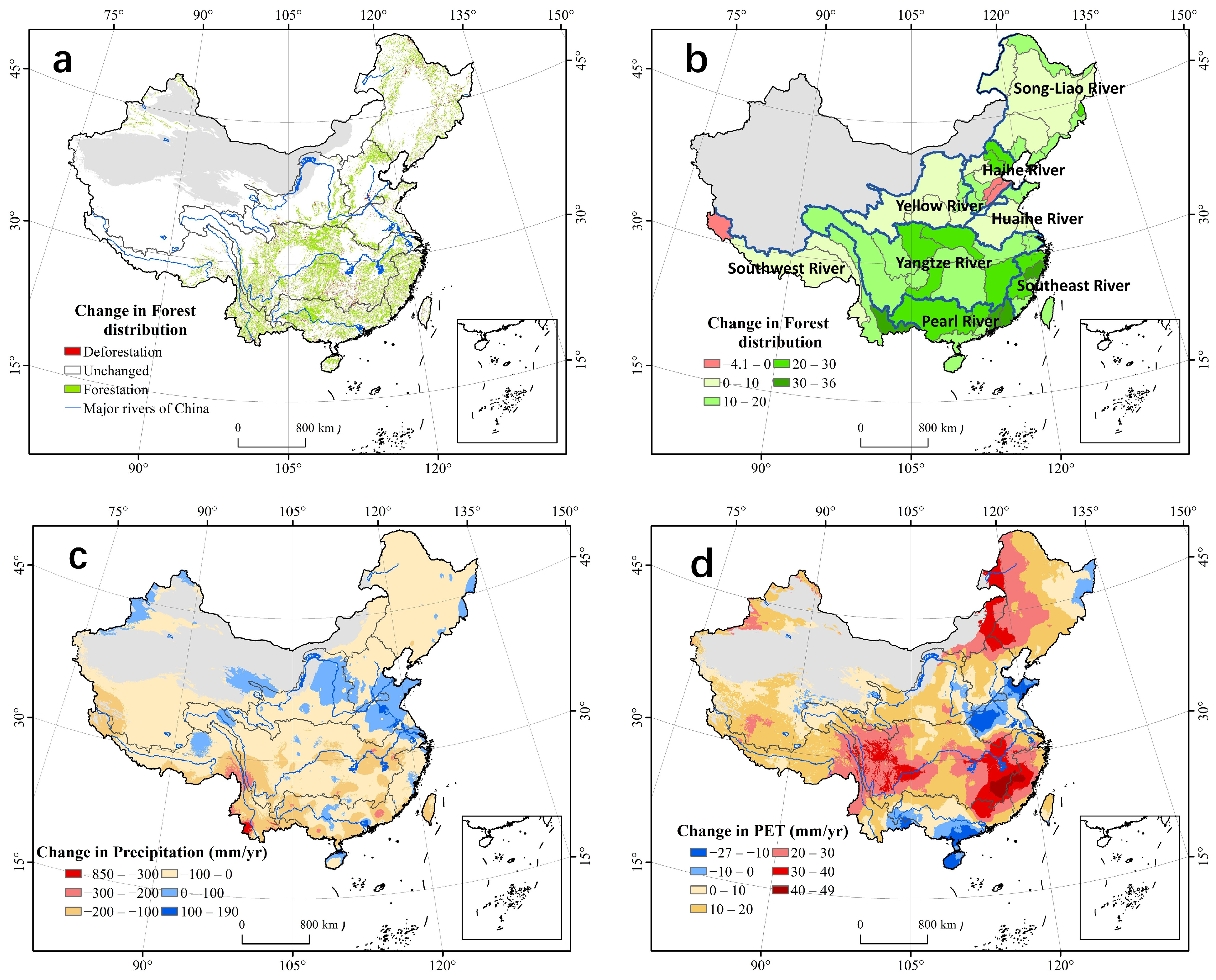
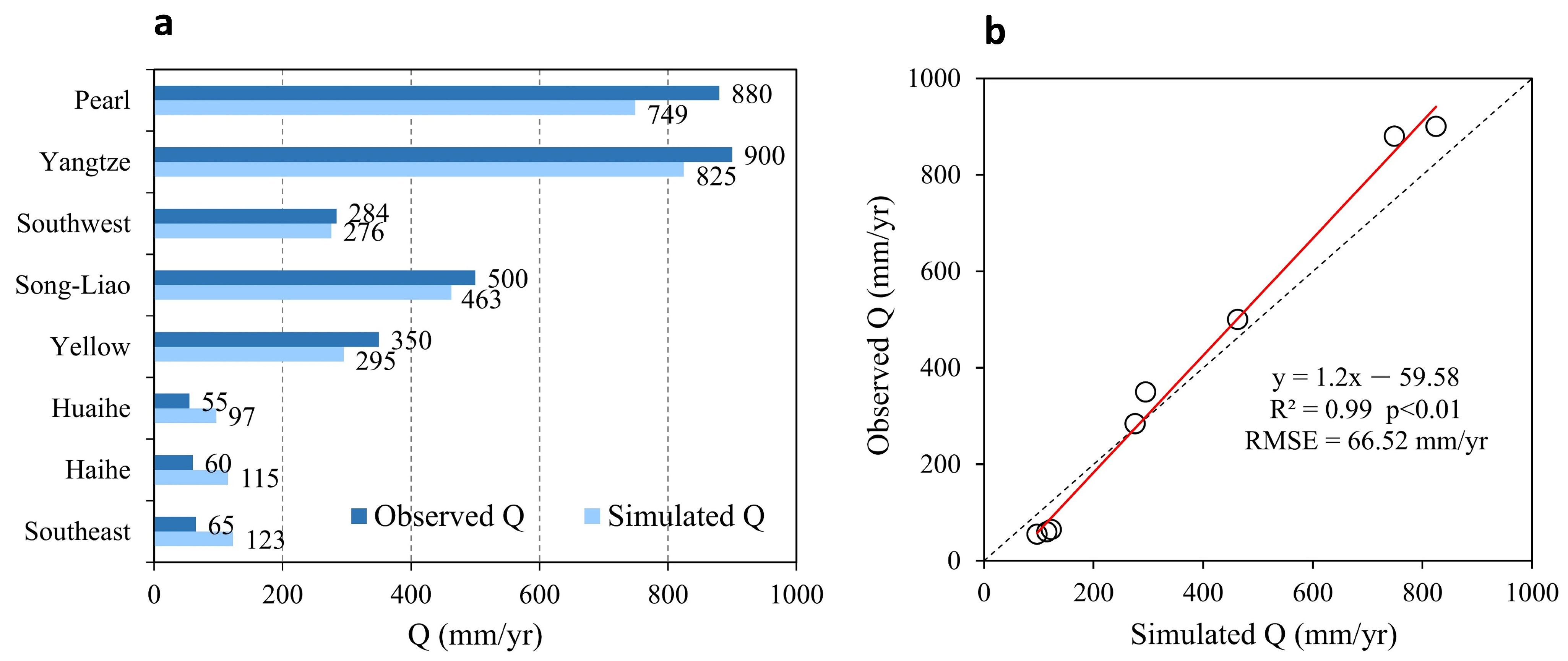



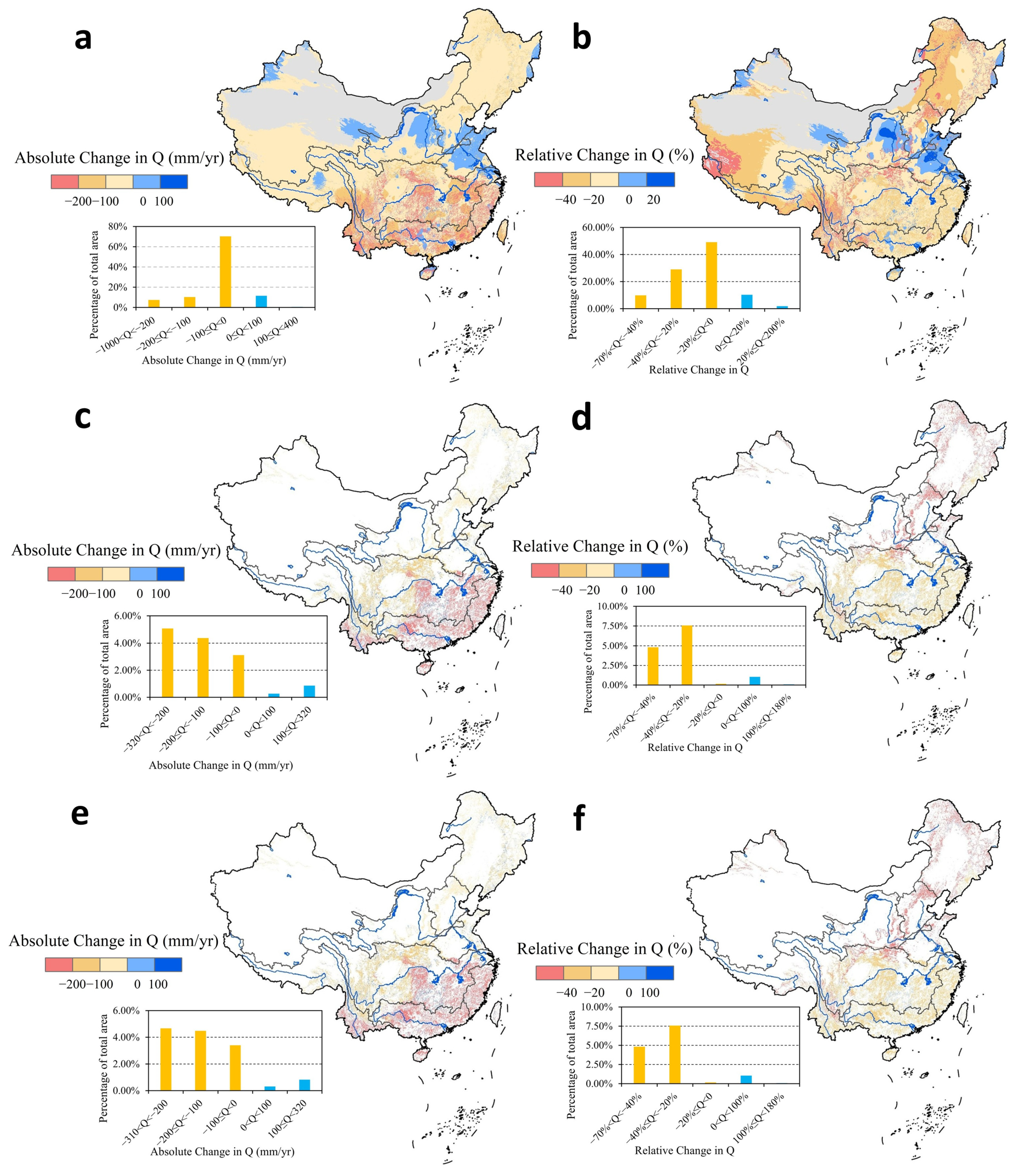
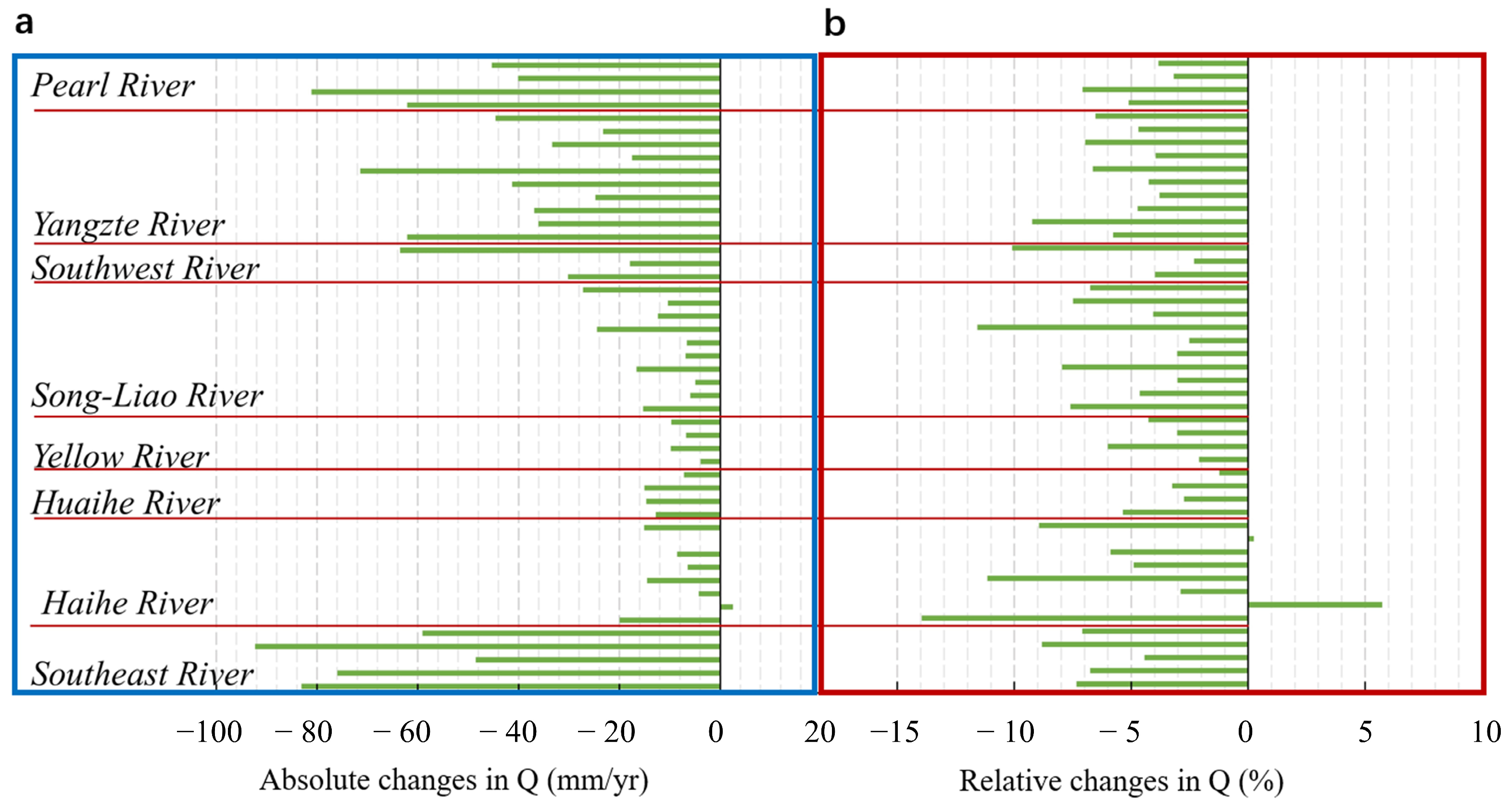
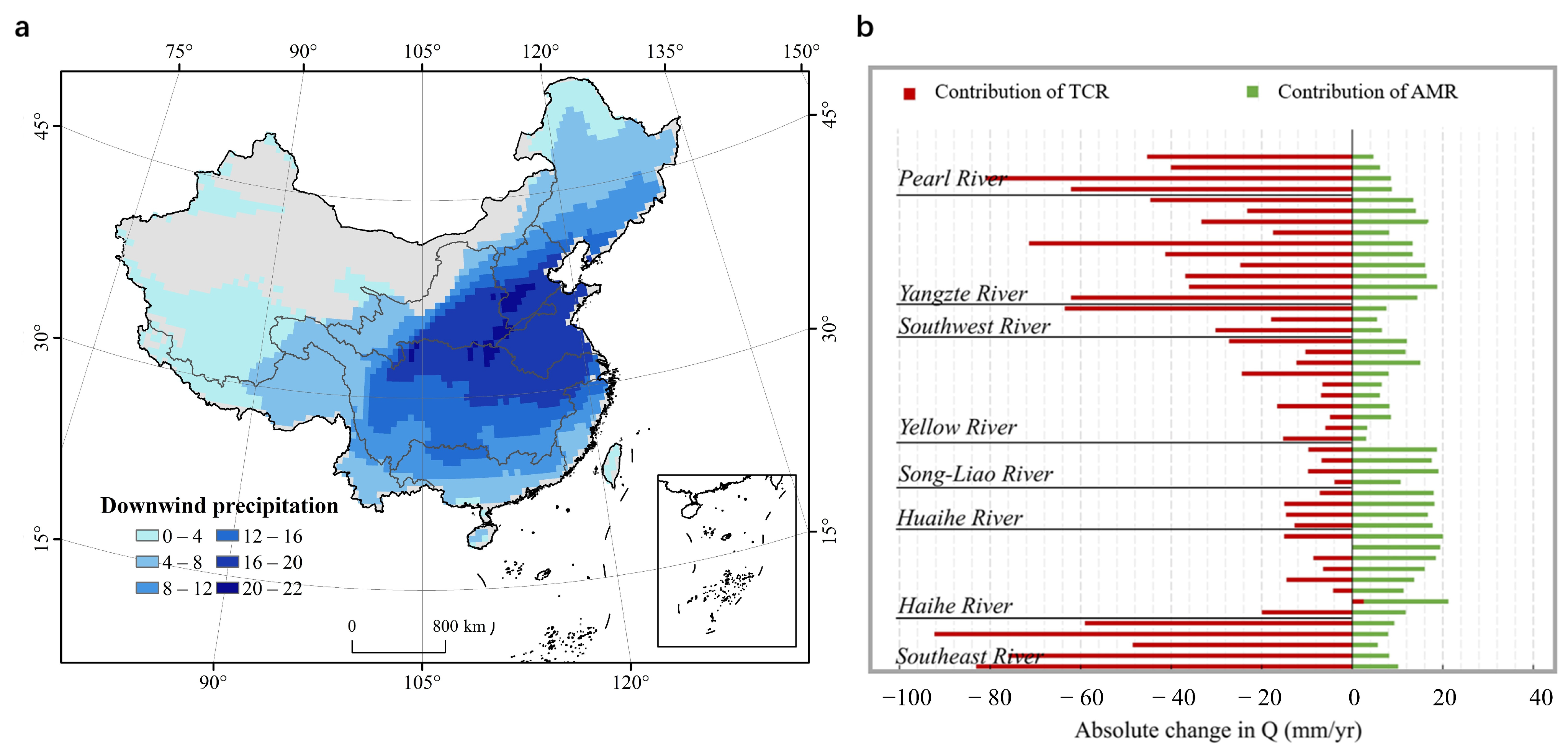

| Scenarios | S1 | S2 | S3 | S4 |
|---|---|---|---|---|
| Forest cover | 1980 | 1980 | 2015 | 2015 |
| Climate | 1980–1999 | 2000–2020 | 1980–1999 | 2000–2020 |
| Simulation Experiments | Both Effects | Forest Cover Effects | |
|---|---|---|---|
| A | B | C | |
| Absolute water yield change (mm yr−1) | S4 − S1 | S3 − S1 | S4 − S2 |
| Relative water yield change (%) | (S4 − S1)/S1 | (S3 − S1)/S1 | (S4 − S2)/S2 |
Disclaimer/Publisher’s Note: The statements, opinions and data contained in all publications are solely those of the individual author(s) and contributor(s) and not of MDPI and/or the editor(s). MDPI and/or the editor(s) disclaim responsibility for any injury to people or property resulting from any ideas, methods, instructions or products referred to in the content. |
© 2025 by the authors. Licensee MDPI, Basel, Switzerland. This article is an open access article distributed under the terms and conditions of the Creative Commons Attribution (CC BY) license (https://creativecommons.org/licenses/by/4.0/).
Share and Cite
Zhang, Y.; Hao, L. Direct and Indirect Effects of Large-Scale Forest Restoration on Water Yield in China’s Large River Basins. Remote Sens. 2025, 17, 1581. https://doi.org/10.3390/rs17091581
Zhang Y, Hao L. Direct and Indirect Effects of Large-Scale Forest Restoration on Water Yield in China’s Large River Basins. Remote Sensing. 2025; 17(9):1581. https://doi.org/10.3390/rs17091581
Chicago/Turabian StyleZhang, Yaoqi, and Lu Hao. 2025. "Direct and Indirect Effects of Large-Scale Forest Restoration on Water Yield in China’s Large River Basins" Remote Sensing 17, no. 9: 1581. https://doi.org/10.3390/rs17091581
APA StyleZhang, Y., & Hao, L. (2025). Direct and Indirect Effects of Large-Scale Forest Restoration on Water Yield in China’s Large River Basins. Remote Sensing, 17(9), 1581. https://doi.org/10.3390/rs17091581







